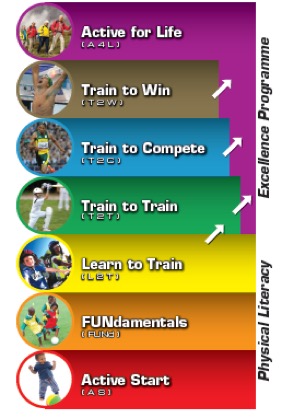Long term participant development
A life-long love for sport
In order for a coach to be able to create a lifelong participation in sports, and to develop a person’s full capacity as an athlete it is of very big importance to understand what to do during the different stages of the Long-Term Participant Development.
The first thing to keep in mind is that the love for sports is born from a person’s positive experience of the sporting environment. No matter how good a coach is in technical details she will only succeed if she creates a positive and safe learning environment.

| Active for life | At any age | Transition from competitive to recreational participation. |
| Train to win | 18+ | Optimizing of performance. High pressure games to develop consistency. |
| Train to compete | 14-18 years | Perform skills in a variety of competitive conditions |
| Train to train | 11-14 years | Focus on sport specific skills |
| Learn to train | 8-11 years | Focus on fundamental sport skills, ie. Invasion, fielding, striking, net/wall |
| FUNdamentals | 6-8 years | Focus on fundamental movement skills |
| Active start | 0-6 years | Development of fundamental movement (ABC), as a fun part of everyday life. |
To read more about the stages of the Long-Term Participant Development, visit http://hp.sascoc.co.za/files/2011/07/SA-Sport-for-Life-Long-Term-Participant-Development.pdf
Links
Fundamentals of movement & fundamental movement skills
In order for a person to become good in sports, she must have good control over her body. It is of big importance to put a lot of focus on the ABCs of movement in practice, especially with children and youth.
During the adolescence the limbs are growing out of proportion, and skills gained before puberty might become very challenging. It is important to recognize the frustration this will bring to the athlete, and therefor reduce the difficulty in the agility and coordination drills during a period if needed.
Good agility, balance and coordination is not only promoting better sporting ability, but is also reducing the risk for injuries.
Agility
Agility is the ability to do quick changes of direction.
Balance
Balance is the ability to keep the body posture, no matter impact from movements and the environment.
Coordination
Coordination is the ability to move different body parts in sync and effortlessly, in order to perform a certain task
- Eye-hand coordination
- Eye-foot coordination
Fundamental movement skills
- Run
- Hop
- Jump
- Twist
- Kick
- Catch
- Throw
In order for a coach to be able to create a lifelong participation in sports, and to develop a person’s full capacity as an athlete it is of very big importance to understand what to do during the different stages of the Long-Term Participant Development.
The first thing to keep in mind is that the love for sports is born from a person’s positive experience of the sporting environment. No matter how good a coach is in technical details she will only succeed if she creates a positive and safe learning environment.

| Active for life | At any age | Transition from competitive to recreational participation. |
| Train to win | 18+ | Optimizing of performance. High pressure games to develop consistency. |
| Train to compete | 14-18 years | Perform skills in a variety of competitive conditions |
| Train to train | 11-14 years | Focus on sport specific skills |
| Learn to train | 8-11 years | Focus on fundamental sport skills, ie. Invasion, fielding, striking, net/wall |
| FUNdamentals | 6-8 years | Focus on fundamental movement skills |
| Active start | 0-6 years | Development of fundamental movement (ABC), as a fun part of everyday life. |
To read more about the stages of the Long-Term Participant Development, visit http://hp.sascoc.co.za/files/2011/07/SA-Sport-for-Life-Long-Term-Participant-Development.pdf
Links
Fundamentals of movement
In order for a person to become good in sports, she must have good control over her body. It is of big importance to put a lot of focus on the ABCs of movement in practice, especially with children and youth.
During the adolescence the limbs are growing out of proportion, and skills gained before puberty might become very challenging. It is important to recognize the frustration this will bring to the athlete, and therefor reduce the difficulty in the agility and coordination drills during a period if needed.
Good agility, balance and coordination is not only promoting better sporting ability, but is also reducing the risk for injuries.
Agility
Agility is the ability to do quick changes of direction.
Balance
Balance is the ability to keep the body posture, no matter impact from movements and the environment.
Coordination
Coordination is the ability to move different body parts in sync and effortlessly, in order to perform a certain task
Eye-hand coordination
Eye-foot coordination
Fundamental movement skills
- Run
- Hop
- Jump
- Twist
- Kick
- Catch
- Throw


